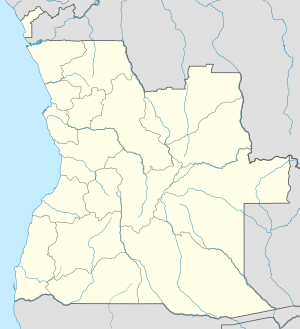Cabinda (city)
You can help expand this article with text translated from the corresponding article in Portuguese. (February 2011) Click [show] for important translation instructions.
|
Cabinda
Chioua | |
|---|---|
Municipality and city | |
| The Chapel of Rainha do Mundo in the City of Cabinda The Chapel of Rainha do Mundo in the City of Cabinda | |
| Coordinates: 5°33′36″S 12°11′24″E / 5.56000°S 12.19000°E | |
| Country | |
| Admin. division | Cabinda province |
| Founded | 1883 |
| City Status | 1956 |
| Area | |
| • Total | 2,273 km2 (878 sq mi) |
| Elevation | 24 m (79 ft) |
| Population (mid 2020)[1] | |
| • Total | 739,182 |
| • Density | 330/km2 (840/sq mi) |
| Climate | Aw |
Cabinda, also know Chioua,[2] is a city and a municipality located in the Cabinda Province, an exclave of Angola. Angolan sovereignty over Cabinda is disputed by the secessionist Republic of Cabinda. The city of Cabinda had a population of 550,000[3] and the municipality a population of 624,646, at the 2014 Census. The residents of the city are known as Cabindas or Fiotes. Cabinda, due to its proximity to rich oil reserves, serves as one of Angola's main oil ports.[4][5]
History
The city was founded by the Portuguese in 1883 after the signing of the Treaty of Simulambuco, in the same period as the Berlin Conference.
There are considerable offshore oil reserves nearby.
Geography
Cabinda is located on the Atlantic Ocean coast in the south of Cabinda Province, and sits on the right bank of the Bele River.[4] It is 56 kilometres (35 mi) north of Moanda (DR Congo), 70 kilometres (43 mi) north of Congo River estuary and 137 kilometres (85 mi) south of Pointe-Noire (Rep. Congo).[6]
Districts
The city of Cabinda is divided into three districts, or comuna:
- Cabinda, the city seat, with 88.6% of the population the city
- Malembo, with 3.1%
- Tando-Zinze, with 8.3%[7]
Education
Universities:
Culture
The city's population has a peculiar culture from its way of dressing and eating to traditional rituals, especially Chicumbe and celebrated ceremonies of Bakamas do Tchizo,[8] a traditional ritual that enables the interaction between the living and the occult spirits of the gods and the ancestors, thus ensuring the reconciliation between the dead and the living.[9]
Language
Ibinda, a Bantu language, is the primary language of both the city and province of Cabinda.[5] Portuguese, the official language of Angola, is also spoken, though mostly as an administrative role. Since Cabinda was colonized relatively later (late nineteenth century) by Portugal compared to most of Angola, Portuguese isn't as widely spoken, though language speakers are rapidly growing in number.
Transport
In 2012, a proposed railway connection to the main Angolan system has to cross territory of the Democratic Republic of the Congo.[citation needed]
See also
References
- ^ Citypopulation.de Population of provinces and municipalities in Angola
- ^ LaGamma, Alisa (2015). Kongo – Power and Majesty. New York: The Metropolitan Museum of Art.
- ^ Citypopulation.de Population of the major cities in Angola
- ^ a b "Cabinda". Encyclopædia Britannica. Encyclopædia Britannica Inc. 2014. Retrieved 2014-06-21.
- ^ a b "Cabinda" (in Portuguese). Luanda, Angola: Info-Angola. 2014. Archived from the original on 2015-11-25. Retrieved 2014-05-21.
- ^ "Cabinda (city)" (Map). Google Maps.
- ^ "Region 1: Cabinda". Postcode Query. 2014. Retrieved 2014-06-21.
- ^ "Cidade de Cabinda comemora 52 anos" [Cabinda city celebrates 52 years] (in Portuguese). Governo da Província de Cabinda. Retrieved 2019-03-19.[permanent dead link]
- ^ "Uma excursão virtual a Cabinda" [A virtual tour to Cabinda] (in Portuguese). Teia Portuguesa. Archived from the original on 2008-07-25. Retrieved 2019-03-19.
Bibliography
- Esteves Pereira; Guilherme Rodrigues, eds. (1906). "Cabinda". Portugal: Diccionario Historico... (in Portuguese). Vol. 2. Lisbon: Joao Romano Torres. OCLC 865826167.
{{cite book}}: External link in|chapterurl=|chapterurl=ignored (|chapter-url=suggested) (help)
External links
- Profile of Cabinda Municipality (in Portuguese)
 Media related to Cabinda (city) at Wikimedia Commons
Media related to Cabinda (city) at Wikimedia Commons


